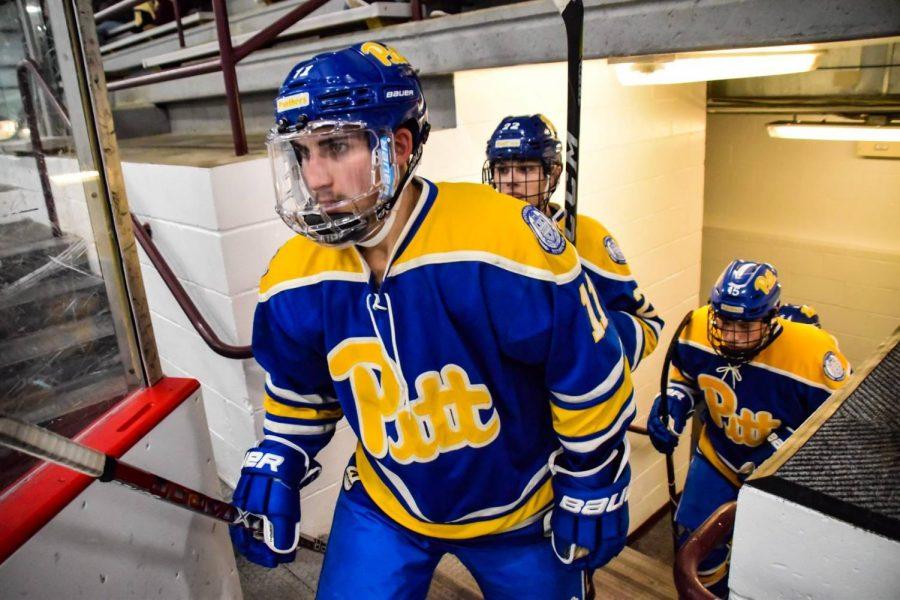Column | Pittsburgh is a proven hockey market. It’s time to give the City a college team.
Image courtesy of University of Pittsburgh Ice Hockey
Pittsburgh is an established hockey town. But for years, it has lacked an element that would exponentially expand on the sport’s impact at a regional level: a Division I level team at Pitt.
May 26, 2021
The Pittsburgh Penguins faced the New York Islanders in game five of their first round series against the New York Islanders on Monday night and were permitted to fill 50% of PPG Paints Arena for the first time all season. There was once again a palpable energy within the venue lying just down the road from Pitt’s campus.
Just over a month ago, PPG Paints Arena hosted the Frozen Four — the NCAA’s grand finale to the collegiate hockey season. After three exhilarating contests — featuring UMass, Minnesota Duluth, St. Cloud State and Minnesota State — Massachusetts defeated St. Cloud State to claim their first national title in program history.
While the Steel City was an obvious choice to host the tournament due to their state-of-the-art arena and regional interest in the sport, Pittsburgh fans had no chance of seeing a team of their own in the annual event.
The Penguins have grown into one of the most consistently successful franchises in all of professional sports since the turn of the century and the Pittsburgh hockey scene has boomed as a result. Hockey has been ingrained within the culture of the town — black and gold jerseys reading “Lemieux” and “Crosby” are commonly seen while walking through downtown. In a town that lives and dies with their sports teams, the once-lowly NHL franchise is now seen as a centerpiece of life within western Pennsylvania.
Pittsburgh is now an established hockey town. But for years, it has lacked an element that would exponentially expand on the sport’s impact at a regional level — a Division I level team at Pitt.
For decades, college hockey had been centered around northern states such as Minnesota and the Dakotas, with very little outreach to demographics lying outside of Canada and the northernmost parts of the United States. The young players who had developed into professionals almost exclusively grew up skating on frozen ponds playing the game that had been passed down to them through generations. But in the last decade or so, the North American collegiate hockey landscape has experienced a dramatic shift in recent years.
The college market, previously dominated by northern schools such as Minnesota and Michigan, has welcomed newcomers from all across the country — even from as far as Tempe, Arizona. The Arizona State hockey team started the process to make the leap to Division I hockey status in 2014 and played their inaugural season in 2015. Since making the move upward, Arizona State has become a hot ticket in recent years, even earning a bid into the NCAA Tournament in 2019. While the state has recently produced world-class talent such as Auston Matthews, Arizona isn’t the only southern market to embrace the sport in recent years. Even the NHL threw a team in the middle of a desert in 2017, which turned out to be a wildly successful endeavor as the Vegas Golden Knights have taken the hockey world by storm.
If college hockey can thrive in Arizona, it can in Pittsburgh.
One point that will undoubtedly be brought to the hypothetical table in discussions to award Pitt a hockey team will be the fact that the City already hosts a D-I program in Robert Morris. While true, the Colonials lack the brand recognition that the Panthers could bring to collegiate hockey within the region. Not only would the Panthers draw newfound interest at the college level, they would give the fans of Pittsburgh something they have yet to experience — an intracity hockey rivalry.
Boston has embraced its collegiate intracity hockey rivalries in stride, setting an example for Pittsburgh to follow. The TD Garden in Boston hosts an annual tournament known as The Beanpot, featuring the local college teams of Boston College, Harvard, Northeastern and Boston University in a two week event that has become a cultural phenomenon within the region. A second collegiate hockey team in Pittsburgh would open the doors to holding a similar annual event at PPG Paints Arena. Also, Penn State, another relatively new D-I program, would present an immediate rival for Pitt and draw massive amounts of interest from fans and players alike. The two schools recently played their final football game for an indefinite amount of time and the expansion of collegiate hockey to Pittsburgh would give a new life to the storied rivalry between the two Keystone State schools.
But the biggest hurdle to a team in the Steel City lies in where the team would play. The initial thought may be to host games at PPG Paints Arena, but this might be difficult for a number of reasons — the biggest of which would be from a logistical standpoint. Not only would Pitt need to coordinate their schedule with that of the Penguins, but calling the arena home may force Pitt to sacrifice one of the things that makes college hockey so special — a student section. While the die-hards would undoubtedly make the 15-or-so minute bus trip to the arena for games, it wouldn’t be practical for students with prior engagements or an early class the next day. Unlike football, hockey often has more than three games per week — something that would be a tough sell for students who aren’t as passionate about sports as others.
The best option would likely be to either renovate the Petersen Events Center to make it hockey-friendly or build an entirely separate arena to accommodate the team. The former may sound a tad outlandish, but the hybrid facility is far from unprecedented — even at the college level. While building a new ice arena to house the team would also present various issues, the on-campus venue would undoubtedly be something that would draw the interest of many. Both options would surely be a massive commitment on the part of the athletic department, but administrators have shown they aren’t afraid to pull the trigger when it comes to building for the future of Pitt athletics.
For an athletic program that has been stuck in neutral for far too long, a hockey team may be just what the doctor ordered.



